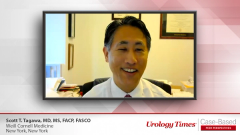
Urothelial Carcinoma: Safety Profile of Enfortumab Vedotin and Pembrolizumab
An overview of the toxicity profile of enfortumab vedotin and pembrolizumab in patients being treated for urothelial carcinoma.
Episodes in this series

Case 2: A 76-Year Old Man with Locally Advanced, Resectable Urothelial Carcinoma
Initial Clinical Presentation:
- A 76-year-old man presented to the clinic with complaints of dizziness and hematuria.
- PMH: hypercholesterolemia (well controlled with medication) and mild COPD.
- SH: Patient does not smoke or drink alcohol.
Initial Clinical Workup:
- CT Imaging: Chest, abdomen, and pelvis revealed a 3.5-cm mass in the bladder and multiple liver metastases.
- ECOG PS 1
- eGFR > 60 mL/min (cisplatin-eligible kidney function)
- Lung Biopsy confirmed stage IV urothelial carcinoma.
- Molecular testing: FGFR2/3 mutation and fusion negative
Treatment and Disease Progression:
- Patient is initiated with neoadjuvant gemcitabine plus cisplatin for 4 cycles.
- He achieved a partial response following chemotherapy.
- Following neoadjuvant therapy, the patient undergoes surgical resection of the tumor.
- While discussed with his oncology care team, the patient did not receive maintenance treatment.
- 6 months following surgery, patient demonstrates disease progression based after routine follow up and repeat imaging.
- Patient progresses to muscle-invasive metastatic urothelial carcinoma.
- Patient is started on combination pembrolizumab plus enfortumab vedotin-ejfv.
- Pembrolizumab 200 mg IV every 3 weeks; enfortumab 1.25 mg/kg IV infusion over 30 minutes on Days 1 and 8 for every 21-day cycle.
- 12 hours post-infusion, the patient developed a maculopapular rash and was improved with supportive care (topical hydrocortisone cream).
- Achieves partial response after 6 cycles.
- Following initial systemic therapy, patient is evaluated in a routine follow up visit and demonstrates further disease progression.
- After discussion with his oncology care team, the patient is initiated on sacituzumab govitecan 10 mg/kg IV on D1 and D8 for 21-day cycles.
- 48 hours following start of therapy, patient notices feeling dehydrated and having more frequent bowel movements. His oncologist starts him on oral loperamide to manage his diarrhea. Two days later, the patient’s diarrhea was resolved.
- After discussion with his oncology care team, the patient is initiated on sacituzumab govitecan 10 mg/kg IV on D1 and D8 for 21-day cycles.
This is a synopsis of a Case-Based Peer Perspectives series featuring Scott T. Tagawa, MD, MS, FACP, FASCO, of Weill Cornell Medicine.
Scott T. Tagawa, MD, MS, FACP, FASCO discussed key adverse events and toxicity management with enfortumab vedotin (EV), both as monotherapy and in combination with pembrolizumab.
He first noted that hyperglycemia is a rare but potentially serious toxicity requiring blood glucose monitoring at baseline and during treatment. More common adverse events are skin toxicity and peripheral neuropathy. Skin toxicity manifesting as rash occurs in about half of patients, sometimes shortly after infusion as highlighted in the case presentation. While most rashes resolve with topical therapies, severe reactions like Stevens-Johnson syndrome are possible. Dose delays or reductions may be employed for severe or persistent rash.
Peripheral neuropathy is also common, affecting around 50% of patients with extended EV exposure. Onset is typically later in treatment rather than with first dose. Sensory, motor or mixed neuropathies occur and may be exacerbated by other neurotoxic agents like platinums. Dose reductions or alternate week dosing can allow most patients to continue EV therapy. For painful neuropathies, additional symptomatic management is available.
Dr. Tagawa commented that for some patients who must discontinue EV early for toxicity such as neuropathy, rechallenge may be possible later on. However, other new agents like antibody-drug conjugates are now available, allowing EV discontinuation without loss of subsequent treatment options.
In summary, diligent toxicity monitoring and dose adjustments enable continuity of what is often an effective therapy for advanced urothelial carcinoma. Research continues to optimize therapy duration and combine or sequence EV with other emerging treatments to maximize clinical benefit.
*Video synopsis is AI-generated and reviewed by Urology Times editorial staff.
Newsletter
Stay current with the latest urology news and practice-changing insights — sign up now for the essential updates every urologist needs.



















